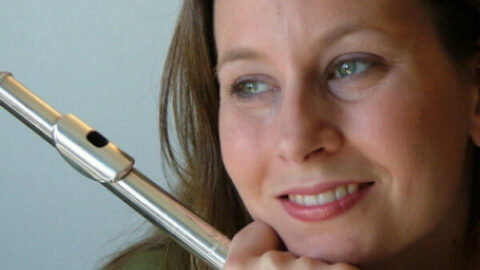 The goal of Jenni Olson’s new album, Dreams of Birds, is to utilize the “full array of tone colors” that the different members of the flute family can produce. Thus the album opens with the eponymous track for alto flute and piano, composed by Jenni Brandon, followed by Alex Shapiro’s Intermezzo for bass flute and harp. Dave Volpe’s Gwinna has Olson playing the traditional C flute, as well as the piccolo.
The goal of Jenni Olson’s new album, Dreams of Birds, is to utilize the “full array of tone colors” that the different members of the flute family can produce. Thus the album opens with the eponymous track for alto flute and piano, composed by Jenni Brandon, followed by Alex Shapiro’s Intermezzo for bass flute and harp. Dave Volpe’s Gwinna has Olson playing the traditional C flute, as well as the piccolo.
All of the pieces are by contemporary, Los Angeles-based composers who are friends and colleagues of Olson’s. The decision to incorporate music written by her friends lends the pieces a very intimate, familiar aspect. Olson’s flute playing is warm, rich, and evocative, with every note a question, suggestion, or innuendo in an ongoing conversation. The other players who join Olson are equally musically expressive; I was particularly moved by the harmonies and dialogue between Olson’s flute(s) and Christin Webb’s bassoon(s) on Volpe’s Riverbed and Bear McCreary’s Incantation.

To my surprise, considering the recency of the compositions, none of the works here contain the kind of pounding dissonance or rhythmic randomness often associated with modern classical music. On the contrary, the harmonies are almost uniformly and pleasantly simple and diatonic. There are splashes of unexpected color in the form of some extended techniques from Olson; among the most notable are the brief flutter-tongued passages in Riverbed and piccolo trills in Incantation. However these departures are not as dissonant or sharp as they could be, merely a bit piquant, a welcome bit of overt spice mixed into subdued dishes.
Unfortunately, I must admit that despite their pleasing qualities, I found most of the pieces on the first half of the album somewhat less than engaging after a few minutes. Their surfaces are simply a bit too even and static, although one could make the argument that these works are, rather, placid or meditative. Furthermore, the alto and bass flute parts are overly simple, consisting primarily of long, held notes in slow melodies; they show off the timbre of the instrument but not much of Olson’s virtuosity as a player.
 The second half of the album picks up the pace a bit. Damian Montano’s composition Dragonfly, for solo piccolo (the only unaccompanied work on the album), begins tranquilly enough, but then quickens into a sort of modern-day Flight of the Bumblebee imitation—and that’s no bad thing. Dragonfly is fast, unpredictable, and to the point; it feels very complete when it concludes at the three-minute mark.
The second half of the album picks up the pace a bit. Damian Montano’s composition Dragonfly, for solo piccolo (the only unaccompanied work on the album), begins tranquilly enough, but then quickens into a sort of modern-day Flight of the Bumblebee imitation—and that’s no bad thing. Dragonfly is fast, unpredictable, and to the point; it feels very complete when it concludes at the three-minute mark.
Next is McCreary’s Incantation, the strongest work on Dreams. This piece is about registral comparison and contrast: at first, extremely low, dark chords on the harp are pitted against the agitations of the piccolo, while later the bass flute and contrabassoon are in mournful counterpoint in octaves normally reserved for single-note supporting lines. Much of this interplay is supported by a pounding, martial percussion line, reminiscent of McCreary’s famous Battlestar Galactica scores. When Webb switches from the contrabassoon to the regular bassoon, and begins playing harmonies above the bass flute, the effect is astounding. Here, finally, we have the true realization of Olson’s goal: by juxtaposing the bass flute with the bassoon, McCreary demonstrates that the largest member of the flute family isn’t just a lower-pitched version of the regular C flute, but in fact its own instrument with its own distinct emotional expressive range.
Joachim Horsley’s Moonrise continues the use of the bass flute. Combined with a piano playing elaborate, haunting arpeggios, the flute melody gradually grows in urgency. There is a piano solo in the middle which is quite technically impressive, ending on a triumphant major chord; the piece then returns to a more somber mood, but still with rapidity and forward energy. Finally, the original theme is stated one more time, quietly, and then there are about six seconds of very pregnant silence. This piece stands out on the album as the one that bears the most fruit upon repeated listens: it is layered and alternates deftly between the dense and the spare.
On the final two works, Olson plays only the standard C flute. Un petit cliché, by Peter Jaffe, manages to be both sprightly and lilting as well as melancholy, with minor and major running together seamlessly. The flute’s melody, though very lyrical, does not rapidly change registers, while the piano is all over the place. However, its chords and brief runs are generally played softly, and so it almost never overtakes the flute’s primacy, and even then only to echo its melody. The piano is like a busy but self-effacing servant whose efforts are necessary to its master’s success.
The last piece, by Daniel Kelley, is entitled A Tripartite Sonata. Movement I begins softly and in a rather abstract, nearly atonal manner, but as it grows in volume, it is also suddenly a rag, full of jazzy harmonies and well-familiar syncopations. (It reminded me strongly of Jean-Pierre Rampal’s renditions of Scott Joplin.) This burst of color is unrelated to most of the body of the piece, which is a sort of late-Romantic style meander, but the Joplin imitation returns in full force at the very end of the movement. The second movement is long, mostly slow and soft, and frankly extremely dull. Neither the flute melody nor the piano harmonies ever go anywhere. Nor does Kelley give Olson anything interesting to do, beyond one or two flutter-tongued notes. Its seven minutes feel like an eternity. Fortunately, the third movement is full of excitement, with a very driving rhythm from the piano and an energetic, forceful melodic argument from the flute. That tune has real shape, too: several times, the flute gradually approaches its upper registers, leaping and bounding all the way, and when the climactic moment is reached, with a brief flourish, the effect is gripping, even electrifying. The finale is even more energetic than the body of the piece, and the ultimate, upward run is like a double exclamation point at the end of a sentence in all caps.
Overall, Dreams is an uneven, but mostly successful, album. Some of the works were not only enjoyable, but met their goal of helping the listener to hear the flute family in a new way. There are several pieces that I intend to listen to repeatedly in the future. Others, regrettably, I will probably skip or even delete. But the good more than makes up for the bad, and this tour of highs and lows in register, volume, and emotion has a few truly transcendent moments.
Jenni Olson, The Dreams of Birds (Delos DE-3434, June 2012) | Buy on Amazon
—
Matt Weber is a New York based composer, educator, and political slacktivist.
























